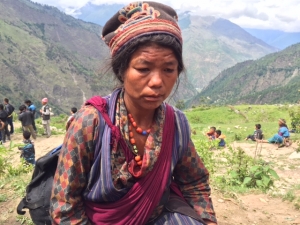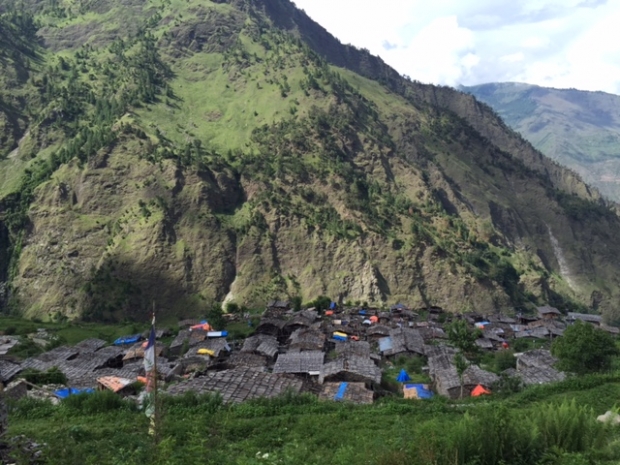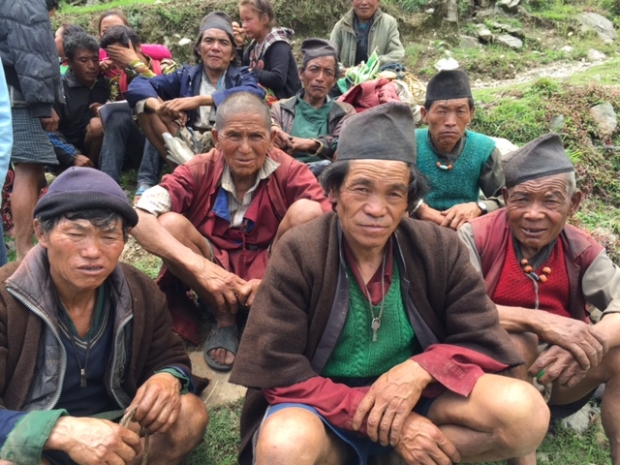
Perspectives
8 MIN READ

The effects of two centuries of exploitation in the Tamang heartland are inhibiting its recovery from the earthquake

This article is the first in a three-part series on the aftermath of the April 2015 earthquake in Nepal. Read Part 2 here and Part 3 here.
I first traveled to Rasuwa district some ten years ago. Just a day’s drive north of Kathmandu, it seemed a different world altogether. High, rocky mountains and pine forests instead of gentle foothills and valleys; mani walls, chortens, and Buddhist prayer flags instead of Hindu shrines and temples; elderly people who spoke Tamang and greeted me with “tashi delek” instead of “namaste”; Tamang women dressed in angdung and syade and men who spoke Nepali with an accent that would invite ridicule in Kathmandu. Everything I encountered along those trails seemed new and unfamiliar, far removed from what I, with my middle class upbringing and education, had been taught to imagine as Nepal.
And yet this, too, was Nepal.

In this less familiar Nepal, in the upper regions of Rasuwa district, lies Gre village. All 166 houses in the village were destroyed when a 7.8 magnitude earthquake struck on April 25, 2015. Two were killed, and dozens more would have died had the entire village not gathered outside to watch an excavator pushing boulders down a ledge, a sight that offered much entertainment.
Among the unlucky was Lakpa Tamang, 46, who was with his mule in Langtang village when a quake-triggered avalanche buried him and hundreds of others, including foreign trekkers. In May, I met Lakpa’s wife, Pasang Bhuti, when I arrived in Gre as part of a volunteer relief group. Like everyone else, Pasang’s family was living under a sheet of tarpaulin, surviving on rations provided by a monastery. She spoke only her mother tongue, Tamang, and barely understood Nepali. Her young neighbor, a tenth-grade student at a school in Syafru Besi, served as our interpreter. Pasang was as traumatized by her husband’s death as by the prospect of having to rear four children by herself. The wages Lakpa earned as a muleteer were her family’s main source of income. The crop they grew on their tiny piece of land was not enough to feed them for the full year.
Three times Pasang asked me if I could take her youngest child, a three-year-old girl, to Kathmandu. She wanted me to place her under the care of an organization that could provide her a good education.
“Kathmandu is far. You won’t get to see your daughter often. Are you sure you want to send her away?” I asked.
“Yes,” she said, “I am helpless here. I cannot support her in any way.”

Pasang’s older daughter, aged nine, had already been taken to Kathmandu by an organization. Neither Pasang nor her sons or neighbors knew its name. I was alarmed. There were reports of child traffickers entering quake-hit villages in the guise of saviors. How could she risk sending her daughter with an organization about which she knew nothing?
“Sadly, parents here are willing to take risks,” said Dawa Norching, who had been helping us with relief work. “The last thing they want is for their children’s lives to resemble their own. They see no future for them in the village.”
:::::
To get to Gre village from Kathmandu, we first drive for nine hours on the blacktopped road and stay overnight in Syafru Besi, a starting point of the Langtang trek. Next morning we drive uphill for two hours on rough road, and then walk for about an hour. In terms of physical distance, Gre is not very far from the capital. Yet you can’t but describe it as a “remote village,” a term that denotes not just physical distance from Kathmandu but also the degree of poverty and deprivation enforced by Kathmandu. It is one of those places where a Kathmandu dweller might travel as a tourist, admiring the beauty of the landscape, lamenting the condition of people.
Most people in Gre are subsistence farmers who grow just enough to make ends meet. They have to walk for two or three hours to reach the nearest health post. There is a school that provides education up to eighth grade. According to Dawa, the quality of education is dismal, language being one of the main problems. The few teachers employed at the school do not speak Tamang. Teaching takes place in Nepali, which the local children can barely grasp. As a result, they have to repeat the same grade for several years. Students who complete eighth grade usually try to continue school in Syafru Besi, but eventually drop out because they cannot keep up with their peers. This leaves them with little hope and low self-esteem. “If the school was any good,” said Dawa, “maybe I wouldn’t have dropped out after seventh grade to become a driver.” He thought for a moment and added, “But maybe I would have. There was no money at home.”
Things were more or less the same in the next village, Gatlang. All the houses had been flattened by the quake. Seven people had lost their lives. For weeks after the earthquake, no relief could reach the village because landslides blocked the roads. Now the road was open but people had yet to receive adequate help. Some complained that their village had been neglected compared to Langtang, which had received much attention in national and international media not only because it suffered terrible devastation, but also because it happened to be a popular trekking destination.

“Our people have no connections in Kathmandu or abroad,” lamented Ashok Tamang, who grew up in Gatlang. “Everyone is poor and illiterate. We have produced no role models. Can you imagine, not a single student who sat for the SLC board exam passed this year.”
The villagers fed us potatoes boiled in their makeshift kitchens before lining up to collect the relief supplies. We distributed cooking pots and some water supply pipes, essentials for which they would have queued even if there had been no earthquake. Their weathered hands and faces spoke of years of hardship and deprivation. They had suffered the impact of a catastrophe far deeper than a sudden tremor of the earth: they were the victims of more than two centuries of systemic exclusion and exploitation.

Few other communities suffered as directly at the hands of Nepal’s ruling class as the Tamang people from the villages now ravaged by the earthquake. For centuries after the creation of the modern Nepali state in 1769, the Tamang were virtually enslaved by Kathmandu’s high-caste rulers. In their study of the Tamang of central Nepal, David Holmberg and Kathryn March have shown how the Tamang people in present-day Rasuwa, Nuwakot, and Dhading—some of the districts worst hit by the quake—were compelled to work as laborers for the ruling elite during the Rana regime. The Tamang were classified as “enslavable alcohol drinkers” in the 1854 civil code. They were forced to collect fodder for royal herding operations; walk for several days to carry dairy products to Kathmandu; work at royal fruit plantations around the Trishuli River; grind charcoal at the gunpowder factory in Nuwakot district; produce paper for the administration, and serve as porters for the military and civil administrations as and when needed. Not only were these workers unpaid, they also had to carry their own rations. Meanwhile, they were forbidden from collecting firewood for themselves or grazing their cattle on land controlled by the royal herding operation. If a Tamang family’s cow strayed into the royal pasture, authorities would beat the owner, not the cow.
Further, high-caste people who migrated into the Tamang heartland used deceit and unscrupulous lending practices to dispossess the Tamang of fertile fields. As Holmberg and March write, “Almost all Tamang have direct experience—if not in their own lives in the lives of their kin—of the appropriation of land through the manipulation of writing related to land.” The descendants of Ranas continue to own large tracts of land in Rasuwa. Locals still remember late Sachit Shamsher Jung Bahadur Rana, former chief of the Army and advisor to King Gyanendra Shah, as the wealthy owner of the apple orchards in Gatlang. Another Rana family is said to own vast stretches of land in Dandagaun.
The end of Rana rule did not mean an end to the oppression of the Tamang. Acts of resistance by the Tamang were met with violent state repression. In 1959, when the Tamang of the aforementioned areas rebelled against exploitative Bahun moneylenders in their villages, King Mahendra’s troops swept into the area to reassert order. Many were arrested and beaten; others were summarily executed. Over the past half-century, Nepal has witnessed three major waves of democracy, including an armed Maoist movement, but the situation of the Tamang has changed little.
:::::
The Tamang community of Yarsa was among those exploited and forced into poverty. Yarsa, which lies on the eastern side of the Trishuli River, was an area in which the Ranas ran their herding operation. Until a few years ago, Yarsa was inaccessible by road. A rough gravel road now connects the village to the highway, but due to lack of public transport, locals still have to trek long distances to get to the nearest health facility or market. Throughout the bumpy four-hour ride from Syaubari through the villages of Yarsa, we did not come across a single vehicle; only locals bent double under the loads on their backs. The earthquake and aftershocks had left parts of Yarsa vulnerable to landslides. The entire community of Ghormu village had been displaced. Many cracked and unstable hillsides were likely to come down in the monsoon rain. Villagers who came to collect relief supplies had to walk, sometimes for up to five hours, past such dangerous hillsides.

Young people of Yarsa see no future for themselves in their villages. Denied basic rights and opportunities in their country, they are forced to seek employment abroad. A large number of young women from Yarsa are working as domestic help in Kuwait and Lebanon. Men mostly work as labor migrants in Malaysia.

“The factory job was tough, but at least I was earning something,” said Gore Ghale, a father of four small children. After years of trying his luck, Gore finally found a job last year in an iron factory in Malaysia. He took a loan at 36 percent interest from a neighbor to cover the cost of travel, recruitment agency fees, and initial expenses at his destination. But a month after he started working, he sustained a head injury on the job and had to be hospitalized for three weeks. After a long recovery, Gore finally resumed work and was beginning to hope for a better life for his family when he heard about the earthquake. He rushed back home in a state of panic. All the houses in the village including his had been destroyed. Nine people had died, including his wife, who was buried by a quake-triggered landslide as she was collecting firewood in the forest. Dazed and distraught, Gore was living under a tarpaulin sheet with his children. If he returned to Malaysia, there would be no one to look after his children. His youngest was only three. If he stayed back, he would not be able to support them or pay off his loans.
“If only,” he said, hesitant to ask, “if only someone would help send my kids to a good school.”

Photo Essays
7 min read
The local shaman’s house, located on the edge of the forest in Tangia Basti, is a space where differences are temporarily suspended
Recommended
Perspectives
7 min read
Rupa Sunar’s act of resistance not only sparked the predictable rage of Bahuns and Chhetris but also unmasked many Janajatis who see themselves as crusaders of justice for the marginalized.
Features
4 min read
An alarming rise in the number of deaths despite low Covid-related fatalities raises doubts over authentic reporting
Features
5 min read
Women from the indigenous Sardar community have long been making mats and vases out of water hyacinth but now, they’re also learning sustainable dyeing methods.
Perspectives
5 min read
A letter from one of our readers reflects on the need for Nepal’s school children to learn at least two languages – one Nepali and the other freely chosen.
Writing journeys
14 min read
Raju Syangtan was once afraid of writing. Today, he is a celebrated poet and journalist. His story, on this week’s Writing Journey.
Features
5 min read
Explosives used during Nepal’s armed conflict continue to take lives
COVID19
News
3 min read
A daily summary of Covid19 related developments that matter